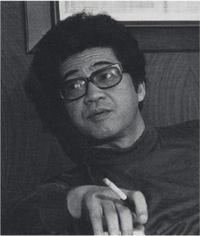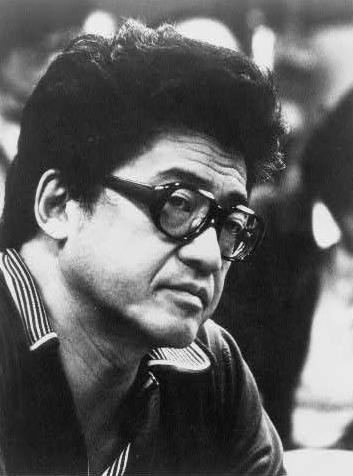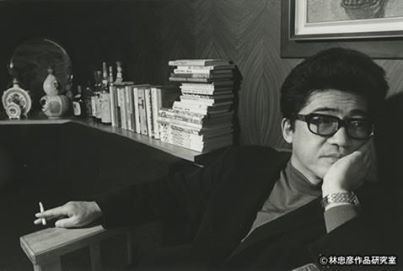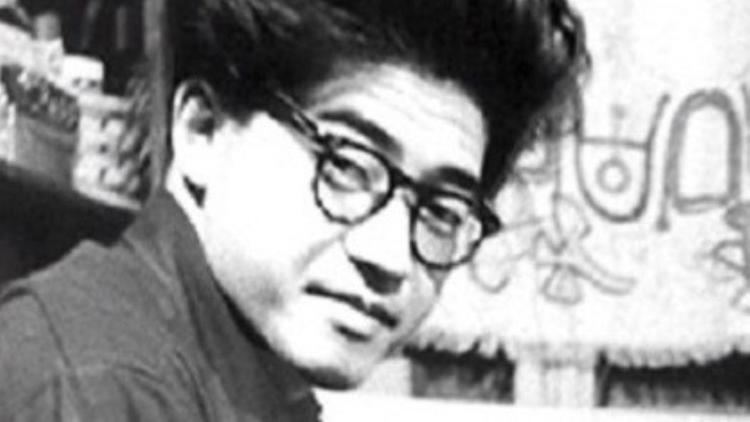Native name 安部 公房 Name Kobo Abe | Occupation Writer Role Writer | |
Born Abe Kimifusa (安部 公房)March 7, 1924Kita, Tokyo, Japan ( 1924-03-07 ) Died January 22, 1993, Tokyo, Japan Spouse Machi Yamada (m. 1945–1993) Movies The Face of Another, Pitfall, Woman in the Dunes, The Man Without a Map, The Box Man, A Poet\'s Life Books Woman in the Dunes, The Face of Another, The Ruined Map, Hako‑Otoko, Kangaroo Notebook Similar People | ||
Teshigahara and abe part one
Kōbō Abe (安部 公房, Abe Kōbō), pseudonym of Kimifusa Abe (安部 公房, Abe Kimifusa, March 7, 1924 – January 22, 1993), was a Japanese writer, playwright, photographer and inventor. Abe has been often compared to Franz Kafka and Alberto Moravia for his modernist sensibilities and his surreal, often nightmarish explorations of individuals in contemporary society.
Contents

Japanese literature recommendations !
Biography

Abe was born on March 7, 1924 in Kita, Tokyo, Japan and grew up in Mukden (now Shenyang) in Manchuria. Abe's family was in Tokyo at the time due to his father's year of medical research in Tokyo. His mother had been raised in Hokkaido, while he experienced childhood in Manchuria. This triplicate assignment of origin was influential to Abe, who told Nancy Shields in a 1978 interview, "I am essentially a man without a hometown. This may be what lies behind the 'hometown phobia' that runs in the depth of my feelings. All things that are valued for their stability offend me." As a child, Abe was interested in insect-collecting, mathematics, and reading. His favorite authors were Fyodor Dostoyevsky, Martin Heidegger, Karl Jaspers, Franz Kafka, Friedrich Nietzsche, and Edgar Allan Poe.

Abe returned to Japan briefly in April 1940 to study at Seijo High School, but a lung condition forced his return to Mukden, where he read Jaspers, Heidegger, Dostoyevsky, and Edmund Husserl. Abe began his studies at Tokyo Imperial University in 1943 to study medicine, partially out of respect for his father, but also because "[t]hose students who specialized in medicine were exempted from becoming soldiers. My friends who chose the humanities were killed in the war." He returned to Manchuria around the end of World War II. Specifically, Abe left the Tokyo University Medical School in October 1944, returning to his father's clinic in Mukden. That winter, his father died of eruptive typhus. Returning to Tokyo with his father's ashes, Abe reentered the medical school. Abe started writing novellas and short stories during his last year in university. He graduated in 1948 with a medical degree, joking once that he was allowed to graduate only on the condition that he would not practice.

Abe had married in 1945 to Machi Yamada, an art student who led a career as artist and stage director, and the couple saw successes within their fields in similar time frames. Initially, however, they had lived in an old barracks within a bombed-out area of the city center. Abe sold pickles and charcoal on the street to pay their bills. The couple joined a number of artistic study groups, such as Yoru no Kai (Group of the Night or The Night Society) and Nihon Bungaku Gakko (Japanese Literary School)'.
As the post-war period progressed, Abe's stance as an intellectual pacifist led to him joining the Japanese Communist Party, with whom he worked to organize laborers in poor parts of Tokyo. Soon after his reception of the Akutagawa Prize in 1951, Abe began to feel the constraints of the Communist Party's rules and regulations alongside doubts about what meaningful artistic works could be created under the title of "socialist realism." By 1956, Abe began writing in solidarity with the Polish rebels and their freedom movement, drawing the ire of the Japanese Communist Party. The Party's criticism reaffirmed his stance: "The Communist Party put pressure on me to change the content of the article and apologize. But I refused. I said I would never change my opinion on the matter. This was my first break with the Party." The next year, Abe traveled to Eastern Europe for the Twentieth Convention of the Soviet Communist Party. Here, confronted by the realities of communist society, Abe saw little of interest, but the arts gave him some solace. He visited Kafka's house in Prague, read Rilke and Karel Čapek, reflected on his idol Lu Xun, and was moved by a Mayakovsky play in Brno.
The invasion of Hungary by the Soviet Union in 1956 disgusted Abe, who attempted to split from the Communist Party. At the time, however, resignations from the party were not accepted. Four years later, in 1962, he was forcibly expelled from the party. His political activity came to an end in 1967 in the form of a statement published by himself, his wife, Yasunari Kawabata, and Kenzaburō Ōe protesting the treatment of writers, artists, and intellectuals in Communist China.
His experiences in Manchuria were also deeply influential on his writing, imprinting terrors and fever dreams which are now surrealist hallmarks of his works. In his recollections of Mukden, these markers are evident: "The fact is, it may not have been trash in the center of the marsh at all; it may have been crows. I do have a memory of thousands of crows flying up from the swamp at dusk, as if the surface of the swamp were being lifted up into the air." The trash of the marsh was a truth of life, as were the crows, yet Abe's recollections of them tie them distinctly. Further experiences with the swamp centered around its use as a staking ground for condemned criminals with "[their] heads--now food for crows-- appearing suddenly out of the darkness and disappearing again, terrified and attracted to us." These ideas are present in much of Abe's work.
Career
He was first published as a poet in 1947 with Mumei-shishū ("Poems of an unknown poet"), which he paid for himself, and as a novelist the following year with, Owarishi michi no shirube ni ("The Road Sign at the End of the Street"), which established his reputation. When Abe received the Akutagawa Prize in 1951, his ability to continue publishing was confirmed. Though he did much work as an avant-garde novelist and playwright, it was not until the publication of The Woman in the Dunes in 1962 that he won widespread international acclaim.
In the 1960s, he collaborated with Japanese director Hiroshi Teshigahara in the film adaptations of The Pitfall, Woman in the Dunes, The Face of Another, and The Man Without a Map. Woman in the Dunes received widespread critical acclaim and was released only four months after he was expelled from the Japanese Communist Party.
In 1971, he founded an acting studio in Tokyo, known as the Abe Studio. Until the end of the decade, he trained performers and directed plays. The decision to found the studio came two years after his first foray into directing his own work, which occurred in 1969 for a production of The Man Who Turned Into A Stick. This production had sets designed by Abe's wife, and starred Hisashi Igawa. Abe had become dissatisfied with ability of the theatre to materialize the abstract, reducing it to a passive medium. Until 1979, Abe wrote, directed, and produced fourteen plays with the Abe Studio. In addition, he published two novels, Box Man (1973) and Secret Rendezvous (1968), alongside a series of essays, musical scores, and photographic exhibits. The Seibu Theater, an avant-garde theater in the new department store Parco, was allegedly established in 1973 specifically for Abe, although many other artists were given the chance to use the cultural "safe zone." The Abe Studio production of The Glasses of Love Are Rose Colored (1973) opened there. Later, the entirety of the Seibu Museum was used to present one of Abe's photographic works, An Exhibition of Images: I.
The Abe Studio provided a foil for much of the contemporary scene in Japanese theater, contrasting the Haiyuza's conventional productions, opting to focus on dramatic, as opposed to physical, expression. Furthermore, it was a safe space for young performers, whom Abe would often recruit from the Toho Gakuen College in Chofu City, on the outskirts of Tokyo, where he taught. The average age of the performers in the studio was about 27 throughout the decade, as members left and fresh faces were brought in. Potential issues arising from difference in stage experience were handled "deftly" by Abe.
He was elected a Foreign Honorary Member of the American Academy of Arts and Sciences in 1977.
"'I simply want to leave within people a legend,' Enomoto says, 'In the hearts of each of them... I want to plant the seeds of dreams.'"
Awards
Among the honors bestowed upon him were the Akutagawa Prize in 1951 for The Crime of S. Karuma, the Yomiuri Prize in 1962 for The Woman in the Dunes, and the Tanizaki Prize in 1967 for the play Friends. Kenzaburō Ōe stated that Abe deserved the Nobel Prize in Literature, which he himself had won. Abe was mentioned multiple times as a possible recipient, but his early death precluded that possibility.
